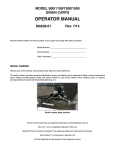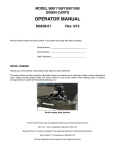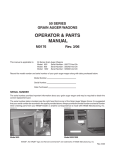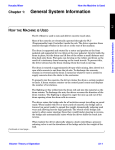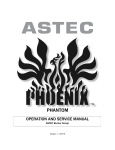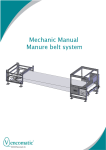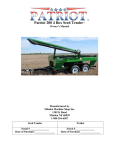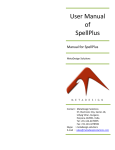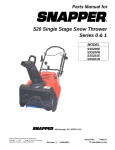Download Fertilizer Service Manual 1 DOUBLE DISC FERTILIZER OPENER
Transcript
Fertilizer Fertilizer Service Manual DOUBLE DISC FERTILIZER OPENER Pin storage position Pin lockup position Maintain 1∕32" - 1⁄16" gap at closest point. Double disc fertilizer opener Position double disc fertilizer openers to place fertilizer no closer than 2" to either side of row. Fertilizer depth is approximately 4" If planter frame is level and at proper 20" operating height. Soil conditions can affect depth slightly. NOTE: Do not set opener depth with spring pressure. Opener is designed to operate against a depth stop and spring up when encountering a foreign object or hard ground. Down pressure spring is factory preset at 250 lb (113.4 kg) but can be adjusted for various soil conditions. 1. Loosen jam nut with a 15∕16" wrench. 2. Use a 1" wrench to turn adjustment bolt clockwise to increase tension or counterclockwise to decrease tension. 3. Tighten jam nut. NOTICE Do not operate double disc openers at full down pressure tension on rocky ground or disc blades will chip. Maintain a gap of 1∕32" to 1∕16" between opener blades at the closest point. Blade adjustment is made by moving inside spacer washers to outer side of blade. Check bearing assembly rivets are not contacting shank after making adjustment. Outer scrapers on each disc blade can be adjusted for wear. Make sure scrapers are adjusted to allow only slight blade contact. Opener assembly is designed to be locked in a raised position when fertilizer attachment is not in use or during storage. 1. Raise planter and place blocks under openers. 2. Lower planter until pivot section hole aligns with mounting bracket hole. 3. Remove lockup pin from mounting bracket storage position and install through lockup hole. 4. Secure with cotter pins. 1 Rev. 9/11 TM Fertilizer Service Manual Fertilizer NOTCHED SINGLE DISC OPENER Middle screw sets blade angle. Tighten first! Opener mount Disc blade ½" hex head cap screws Jam nuts 5∕16" hex head cap screws R.H. Opener Shown ⅜" lock nuts Scraper Drop tube Knife Drop tube tab Notched single disc opener adjustments CAUTION Compressed spring may fly out of this assembly if attempting to disassemble and cause injury. Do not take apart this assembly. Disc blades are sharp and can cut causing serious injury. Wear gloves when working on or turning disc blades by hand. NOTICE Never strike knife with heavy object. Damage to knife will occur. If knife to disc blade clearance is too large, soil or residue can wedge between knife and blade, and blade will not turn. 1. Adjust knife to disc blade contact. Loosen or tighten ⅜" lock nuts to adjust knife’s entire leading edge against disc blade. Turn blade and check for slight resistance without freewheeling. Readjust knife to blade’s tight spot as needed. NOTICE Adjust liquid drop tube out of path of soil flow across knife. Drop tube and tab wear quickly if not correctly adjusted. 2. Adjust scraper and drop tube. Loosen two 5∕16" hex head cap screws. Adjust scraper until just touching disc blade. Adjust drop tube until it is centered between knife and disc blade. Tighten screws. Turn blade and check for slight resistance without freewheeling. Repeat as needed. Insert flat bladed pry bar or screwdriver between knife and drop tube above drop tube tab. Carefully bend tube until ¼"- ⅜" from disc blade. NOTE: Maximum disc blade depth 4" (10.2 cm). 3. Adjust blade depth. Loosen three ½" hex head cap screws and jam nuts in opener mount. Adjust opener assembly up or down to desired blade depth. Tighten center hex head cap screw and jam nut first to set proper disc blade angle. Tighten remaining hex head cap screws and jam nuts. Torque hex head cap screws and jam nuts to 57 ft-lb (77.29 N-m). Check fertilizer hose clearance and adjust as necessary. 2 Rev. 9/11 TM Fertilizer Fertilizer Service Manual RESIDUE WHEEL ATTACHMENT FOR NOTCHED SINGLE DISC FERTILIZER OPENER Notched single disc opener residue wheel attachment Residue wheel attachment for notched single disc fertilizer opener is used where row unit mounted residue wheel attachments cannot be installed. Residue wheel is attached to notched single disc fertilizer opener with ⅝" x 7½" and ½" x 6½" hardware. Maximum depth is set by lifting residue wheel and moving adjustment lever down to increase depth or up to decrease depth in 1" increments (in relation to blade depth setting). Adjust all rows the same. Residue wheel down force is maintained by a torsion spring and is not adjustable. DEPTH/GAUGE WHEEL ATTACHMENT FOR NOTCHED SINGLE DISC FERTILIZER OPENER Notched single disc opener depth/gauge wheel Depth/gauge wheel attachment for notched single disc fertilizer opener is used where additional gauging is required to maintain desired fertilizer opener depth. Depth/gauge wheel is attached to notched single disc fertilizer opener using a mounting block fastened to the pivot arm with ⅝" hardware through disc blade bearing. Depth adjustment is made using 3 adjustment holes in depth/ gauge wheel mounting block. Moving depth/gauge wheel increases/decreases depth in approximate 1" increments in relation to blade depth setting made at vertical mounting post. 3 Rev. 9/11 TM Fertilizer Service Manual Fertilizer HD SINGLE DISC FERTILIZER OPENER Spring preset nut Spring Preset Inside blade depth adjustment nut. Outside blade depth adjustment nut. Block HD single disc opener R.H. configuration shown (Overhead view) Recommended placement of fertilizer with HD single disc fertilizer opener is 3½" - 4" from row. NOTICE Never place fertilizer closer than 2" to row or seeds may be damaged. Maximum blade depth is approximately 5" with planter frame level and at 20" operating height. Soil conditions can affect depth slightly. Raise planter to remove weight from fertilizer opener. Loosen inside adjustment nut with 1⅛" wrench. Turn outside nut clockwise to decrease or counterclockwise to increase blade depth. One full turn of blade depth adjustment nut changes blade depth ⅜". Tighten inside nut tight against block. Adjust all fertilizer openers to same depth. Fertilizer opener down pressure can be adjusted from 250 lb (113.4 kg) to 640 lb (290.3 kg). NOTICE Do not operate HD single disc fertilizer openers at full down pressure tension on rocky ground or disc blades will chip. NOTE: DO NOT adjust spring preset dimension less than 9½". Spring Preset Length Down Pressure NOTE: Excessive down pressure can cause planter frame up-lift and affect machine performance. Planter frame should be 20" from ground in planting position. Excessive down pressure in loose soil conditions can cause openers to run too deep and push dirt ahead of opener and may stop soil press wheel and opener blade from turning. 11" (27.9 cm) 10¾" (27.3 cm) *10½" (26.7 cm) 10¼" (26 cm) 10" (25.4 cm) 9¾" (24.8 cm) 9½" (24.1 cm) Raise planter to remove weight from fertilizer opener. Turn spring preset nut clockwise to increase and counterclockwise to decrease down pressure. Adjust all rows to a similar setting. Minimal spring pressure for acceptable operation is recommended. See chart for spring length settings. 250 lb (113.4 kg) 320 lb (145.1 kg) 370 lb (167.8 kg) 450 lb (204.1 kg) 520 lb (235.8 kg) 580 lb (263.1 kg) 640 lb (290.3 kg) *Initial setting Adjust spring loaded dry fertilizer drop tube/scraper periodically to maintain ⅛" gap between drop tube and opener blade. If this dimension is not maintained fertilizer may not drop in proper location. Adjustment bolt Loosen scraper adjustment bolt. Slotted hole in scraper allows up or down adjustment. ⅛"" ga ⅛ gap 4 Rev. 9/11 TM Fertilizer Fertilizer Service Manual Adjust liquid drop tube/scraper so there is slight contact between blade and scraper lower leading edge, and ¼" clearance between liquid drop tube trailing edge and blade. Blade should turn with minimum amount of drag. Adjustment cap screws s NOTE: Soil press wheel is not for gauging fertilizer opener operating depth. Additional press wheel down pressure may be desirable in heavy moist soils. Turn press wheel spring adjustment bolt clockwise to increase down pressure. Press wheel spring pressure adjustment bolt Press wheel down pressure adjustment HD single disc fertilizer opener can be raised and locked up when fertilizer attachment is not used or during storage. NOTE: A lockup bar automatically raises and locks soil press wheel when blade assembly is raised. 1. Place planter in planting position. Outside adjustment nut 2. Remove outside blade depth adjustment. Block 3. Raise planter until adjustment bolt clears adjustment block. 4. Raise spring to clear blade assembly and raise blade assembly until storage strap can be positioned on lockup pin. Install hair pin clip. 5. Reinstall depth adjustment nut and tighten Storage strap p HD opener lockup 5 Rev. 9/11 TM Fertilizer Service Manual Fertilizer DRY FERTILIZER ATTACHMENT WARNING Agricultural chemicals can cause death or serious injury to persons, animals, and plants or seriously damage soil, equipment, or property. Read and follow all chemical and equipment manufacturers labels and instructions. Dry fertilizer option installed Fertilizer drive rate transmission Rate of fertilizer application is determined by drive/driven sprocket combination on fertilizer drive rate transmission and auger position in the hoppers. Augers positioned for low rate delivery Augers positioned for high rate delivery NOTE: Uneven delivery of fertilizer will occur if high rate auger position is used at too low a rate setting. Remove ¼" stainless steel cap screws holding augers in place on shaft and reposition augers to change delivery rate. A fertilizer transmission is located directly ahead of row unit transmission on right side of planter and allows simple, rapid changes in sprockets to obtain desired fertilizer application rates. Chain tension is controlled by a spring loaded idler adjusted with a ratchet arm located to inside of transmission. Sprockets can be changed with those on the sprocket storage rod by removing hexagon shaft pins. Fertilizer rate charts in Rate Chart section will help you select correct sprocket combinations. NOTE: Make a field check after each sprocket combination adjustment to be sure you are applying fertilizer at desired rate. NOTICE Placing fertilizer too close to seeds or in excessive amounts can cause germination or seedling damage. Check with your fertilizer dealer or manufacturer for correct amount and placement. Because dry fertilizer attachment meters granules by volume rather than weight, differences in brands, and fertilizer analysis, weight metered during actual application may vary considerably. Use chart for reference only. Use a container to catch and measure application for a better estimate. Keep fertilizer dry during use and storage since most fertilizers easily absorb moisture. In addition to waste, deposits of fertilizer left in hopper can cause metal corrosion. Empty hoppers at end of each day. 6 Rev. 9/11 TM Fertilizer Fertilizer Service Manual CLEANING Disconnect drive shaft and hoses Rotate lid to back and rotate hopper forward Dry fertilizer hoppers tip forward for dumping and ease of cleaning. Disconnect drive shaft from transmission and/or adjacent hopper. LOOSEN HOSE CLAMPS AND REMOVE HOSES FROM EACH HOPPER. Remove rear ½" x 1¼" cap screw from between each hopper saddle and hopper mount. Rotate each hopper lid to back side of hopper and carefully tip hopper forward. Flush all loose fertilizer from hoppers and hoses after dumping contents. At end of planting season or when fertilizer attachment is not used for a period of time, hoppers should be disassembled, cleaned, and metal surfaces coated with a rust preventative. Remove ¼" cotter pin and bearing from one end of shaft. Pull auger assembly from opposite end of hopper. Remove stainless steel cap screws from auger shaft and remove all auger components for cleaning. Coat all parts with rust preventative before reassembly. Reinstall auger halves in low or high rate position. Flighting must move chemicals from center to outside of hopper. Transmission direction of rotation Auger installation NOTE: Install auger assembly so the flighting moves material to outer openings in hopper when augers rotate in direction they turn during operation. Slide auger assembly through outlet housing into hopper. Secure in place by reinstalling bearing and cotter pin. Rotating shaft in direction shown to see if flighting (spirals) on auger move toward ends of hopper. If not, remove auger assembly, turn 180°, and reinstall. NOTE: Frequent lubrication of auger bearings is critical to ensure augers turn freely. Check lubrication section for frequency. Be certain augers turn freely. If not, loosen 5∕16" carriage bolts in outlet housings, rotate auger several times, and retighten carriage bolts. This allows housings and augers to realign. NOTE: Do not operate fertilizer attachment without auger baffles in place. Install auger baffles over augers and secure in place with two hair pin clips in each hopper. 7 Rev. 9/11 TM Fertilizer Service Manual Fertilizer LIQUID FERTILIZER ATTACHMENT WARNING Agricultural chemicals can cause death or serious injury to persons, animals, and plants or seriously damage soil, equipment, or property. Read and follow all chemical and equipment manufacturers labels and instructions. CAUTION Prior to 2012 production. Overfilling tank can cause siphoning, tank collapse, personal injury, and damage to property and equipment. Do not overfill tank. Do not leave planter unattended when filling tank. Close fill valve and open tank lid if siphoning occurs. Follow all chemical manufacturers first aid, cleanup, and handling instructions. NOTICE Placing fertilizer too close to seeds or in excessive amounts can cause germination or seedling damage. Check with your fertilizer dealer or manufacturer for correct amount and placement. Liquid fertilizer installed on 3600 ASD CHECK VALVES New style reparable check valve Old style non-reparable check valve Optional low rate check valves are available for in-line installation between liquid fertilizer squeeze or piston pump and openers to ensure equal distribution of product at low rates. Check valves eliminate anti-siphon loops. 8 Rev. 10/11 TM Fertilizer Fertilizer Service Manual SQUEEZE PUMP Squeeze pump rate of liquid fertilizer application is determined by combination of sprockets on squeeze pump drive and driven shafts. Make sure sprockets are in alignment, sprocket retaining collars are tight, and chain is properly tensioned is when changing sprocket combinations. Close all shut-off valves when planter sits overnight or for extended periods of time. It is also important to close tank valves when servicing on pump or hoses. NOTE: Delivery rate chart in Rate Chart section of this manual provides approximate application rate only. Delivery varies with temperature and fertilizer. Discharge manifold rearward Discharge manifold forward Discharge manifold must be repositioned rearward when not in use to prevent hose distortion and prolong hose life. Discharge manifold must be forward when pump is in operation. Loosen wing nuts and slide manifold forward and sideways or rearward as required and retighten wing nuts. NOTICE Avoid excessive pressure using quick fill attachment or rubber plugs installed in manifold may be forced out. If either end pump hoses run off back plate, loosen hose clamps on intake manifold and rotate hose as follows: 1. For right hand hose (facing pump from front of planter as shown) twist hose ¼ turn to right. Turn ¼ left Turn ¼ right 2. For left hand hose (facing front of pump) twist hose ¼ turn to left. 3. Retighten hose clamps. Hose clamp Adjusting squeeze pump end hoses 9 Rev. 9/11 TM Fertilizer Service Manual Fertilizer PISTON PUMP NOTE: Keep manuals shipped with pump and flow divider with this manual. Piston pump Adjusting delivery rate NOTE: Delivery rate chart in Rate Chart section of this manual provides approximate application rate only. Delivery varies with temperature and fertilizer. Loosen ⅜" lock nut that secures arm with pointer and rotate scale flange with adjustment wrench until pointer is over desired scale setting. Tighten ⅜" lock nut. DO NOT OVERTIGHTEN. NOTE: Periodically check flow to all rows. Set rate is delivered to remaining rows if one or more lines are plugged. PISTON PUMP GROUND DRIVE WHEEL SPRING ADJUSTMENT Initial down pressure spring tension on piston pump ground drive wheel,is set leaving 12¼" between the bottom of mounting plate and plug on top of spring. This dimension is taken with planter raised (tire not contacting the ground). Further adjustment can be made to fit conditions. 12¼" NOTE: Piston pump ground drive wheel assembly can be locked in raised position when not in use. Remove two cap screws that attach upper end of spring to spring mount. Reattach spring using upper holes in spring mount. Reverse procedure to reset for field use. CLEANING Clean tanks, hoses, and metering pump thoroughly with water at end of planting season or prior to an extended period of non-use. Do not allow fertilizer to crystallize from cold temperature or evaporation. Screen Sc On machines equipped with piston pump, take apart and clean strainer located between piston pump and ball valve daily. Remove the end cap to clean the screen. See Piston Pump Storage in Maintenance Section of this manual. p End cap 10 Rev. 9/11 TM Lubrication and Maintenance Fertilizer Service Manual FERTILIZER CHECK VALVE CLEANING AND REPAIR Spring Valve ball Gu Guide e O-ring Valve seat Direction of flow 1. Unscrew valve body and separate halves. Note direction and location of parts. 2. Clean and inspect parts. Flush with clean water. Replace damaged parts. 3. Reassemble exactly as shown. O-ring and valve seat must be firmly in place inside each half of valve body. 11 Rev. 9/11 TM












